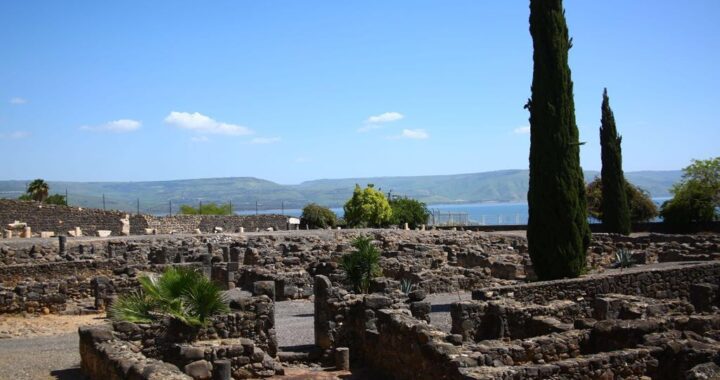The hiker who ascends the lofty mountain and pauses to view the landscape below him can see in one panoramic view the entire forest and its relationship to the landscape around it. The interpreter of the book of Daniel is like this hiker. The student of this book receives a panoramic view of the forest of prophecy and how this forest relates to the theological landscape of God’s sovereign plan. In essence, when one studies the book of Daniel the individual is looking at the big prophetic picture. As John Whitcomb states, “The book of Daniel stands at the very pinnacle of Old Testament prophetic writings, under girded by the massive foundation stones of the books of Moses, most of the prophets, and the poetic books.” 1
Daniel 2 and 7 especially present this sweeping view of prophecy’s direction. These two chapters hold a significant role in understanding the book of Daniel, and this role is demonstrated by the three-fold structure of the book. Chapter 1 serves as an introduction, chapters 2-7 focus mainly on the Gentile nations, and chapters 8-12 focus mainly on the nation of Israel. The foundation for this understanding rests on the differences in the languages of the book, both Hebrew (1, 8-12) and Aramaic (2-7). 2 In the second section, chapter 2 relates to both history and prophecy and forms a parenthesis with chapter 7. Both chapters are parallel despite the differing details. The rest of this unit also contains parallels. Chapters 3 and 6 relate to the Gentile persecution of the Israelites as demonstrated by the fiery furnace and the lions’ den. Chapters 4 and 5 discuss the visions of Nebuchadnezzar and Belshazzar and Daniel’s interpretation of these visions. 3 Daniel 2 and 7 are broad in their topics and lead to the central focus of chapters 4 and 5, in which Nebuchadnezzar and Belshazzar learn of God’s sovereignty. This theological concept of God’s sovereignty over kings and kingdoms is the theme of the book. Nebuchadnezzar especially expressed this theme in 4:17 and 34-35. Each account or vision demonstrates God’s control and direction of the affairs of men to bring about His desired plan. Stephen Miller correctly states, “Every page reflects the author’s [Daniel’s] conviction that his God was the Lord of individuals, nations, and all of history.” 4
Daniel 2 presents Nebuchadnezzar’s dream of a golden image. The first section of the chapter discusses the king’s demand for an interpretation of his dream (vv. 1-23). The second section presents the interpretation of the dream (vv. 24-47), and the final section presents Nebuchadnezzar’s reaction (vv. 46-47). The details of the king’s dream are as follows (vv. 31- 35):
- Head of gold
- Chest and arms of silver
- Middle and thighs of bronze
- Legs of iron
- Feet of part iron and clay
- Uncut stone that crushes the image
- Iron, clay, bronze, silver, gold that become chaff and are blown away by the wind
Daniel interpreted the dream in verses 36-45. The head of gold is Nebuchadnezzar and the Babylonian Empire. Verses 37-38 state, “You, O king, … are the head of gold.” In prophecy, kings and kingdoms are often linked. The Babylonian Empire was not very successful after Nebuchadnezzar’s death falling to the Medo-Persian Empire about twenty-three years later. 5 Daniel recorded in chapter 5 this take over by Medo-Persia. This new kingdom is the one referred to in 2:39 as “another kingdom inferior to” Nebuchadnezzar. Just as silver is secondary to gold and the chest is secondary to the head, the Medo-Persian Empire was secondary to the Babylonian Empire. 6 The Medo-Persian Empire was inferior to the previous kingdom because its king did not have absolute power. He was bound by the “law of Medes and Persians that no injunction … can be changed” (6:15). The new empire lasted for about 208 years, dating from 539-331 B.C. 7
Daniel continued his interpretation in verse 39 by stating that a third kingdom would follow the second one. This new kingdom was Greece, which lasted from about 331 to 31 B.C. Alexander the Great formed the kingdom but died in 323 B.C. His kingdom was divided into four sections with each one being ruled by one of his generals, a point discussed in the seventh chapter. 8 This kingdom did not have the authority or the power of the previous kingdom.
Daniel moved to the next kingdom, the one “strong as iron” (v. 40). This empire was symbolized by iron, which has less value than the other metals. Rome followed the Grecian Empire, and the description was appropriate for Rome. Miller notes, “Rome ruled the nations with an iron hand and like a huge iron club shattered all who resisted its will.” 9 He dates the Roman Empire from 146 B.C. to A.D. 395 when it split into the European and Western Empires. 10
Up to this point in the chapter, all the prophecies have been fulfilled. This literal fulfillment enables us to interpret the rest of the chapter in a literal manner. The feet of iron and clay will be a future aspect of a Roman Empire but will not be completely unified. Iron and clay do not form a tight bond. The uncut stone will be the coming of Christ, who will crush the future Roman Empire and establish a world-wide kingdom that we refer to as the Millennial Kingdom (vv. 43-45).
Daniel 7 presents Daniel’s dream of the four beasts. The first section of the chapter discusses Daniel’s dream (vv. 1-14), the second section provides the interpretation of the dream (vv. 15-27), and the third section indicates Daniel’s reaction to the dream (v. 28). The details of Daniel’s dream are as follows (vv. 2-8):
- A lion
- A bear
- A leopard
- A dreadful beast
The lion of verse 4 had wings of an eagle, but the wings were “plucked off.” The lion then stood up as a man. The plucking of the wings corresponds to the insanity and humiliation of Nebuchadnezzar in Daniel 4. The lion standing and having “the mind of a man” symbolizes Nebuchadnezzar’s return to sanity. Wood points out, “A humanitarian interest came to play a major role in his life, rather than the former ‘beastly’ lust for power.” 11 The second beast of verse 5 was a bear that “was raised up on one side” and “had three ribs in its mouth.” As seen in chapter 2, the Medo-Persian Empire followed the Babylonian Empire. The Persian aspect of the empire was stronger than the Median aspect. This difference explains the bear’s awkward stance. The three ribs represent the three great conquests of King Cyrus and his son, Cambyses. These conquests are as follows: 12
- Lydia in Asia Minor in 546 B.C.
- The Babylonian Empire in 539 B.C.
- Egypt (by Cambyses) in 525 B.C.
The third beast was a leopard “with four wings of a bird on its back” and four heads (v. 6). The empire that defeated the Persians was the Grecian Empire. The symbol of a leopard with four wings indicates the great speed of the Greeks to world power. Alexander the Great began his invasion of the Persian Empire in 334 B.C. with an army of 35,000 men. He took just ten to eleven years to conquer the known world and reach India. He died at the age of 32 or 33 in Babylon of a fever in June, 323. 13 Following Alexander’s death, the empire was divided among his four generals, which fulfilled the symbol of the leopard’s four heads. The divisions of the empire were as follows. 14
- Babylon and Northern Syria—Antigonus and later by Seleucus I Nicator
- Egypt—Ptolemy I Soter
- Macedonia—Cassander
- Thrace and Bithynia—Lysimachus
The fourth beast is described as “terrifying and dreadful and exceedingly strong” (v. 7). The great strength is indicated by the iron teeth that provide an unbreakable weapon. This beast symbolizes the Roman Empire that defeated the Greeks. The iron of this animal parallels the iron of the legs and feet of chapter 2. Archer points out that “the mention of iron in the teeth suggests the legs and toes of iron in the image.” 15 Verse 8 moves from the historical fulfillment of the Roman Empire (from our perspective) to the prophetic fulfillment of the future Roman Empire.
When we consider the prophecies of chapters 2 and 7, we can see the parallels between the two chapters. They are as follows:
- Babylon—Head, Gold, Lion
- Medo-Persia—Chest, Silver, Bear
- Greece—Midsection, Bronze, Leopard
- Rome—Legs and feet, Iron and Iron/Clay, Dreadful Beast
Comprehending the interpretation of Daniel 2 and 7 assists the biblical student to understand the broad scope of prophetic revelation, the “prophetic forest.” As one comprehends the past, the individual can comprehend the future. These two chapters contain portions of revelation that already have been fulfilled. Much of the symbolism in these chapters has found a literal fulfillment in an historical reality. This interpretative connection provides the reader with a framework to understand the unfulfilled portions in the two chapters. If the majority of Daniel 2 and 7 find their reality in political kingdoms, this connection leads the interpreter to believe that the unfulfilled portions of chapters 2 and 7 will also be fulfilled in the future by literal political kingdoms. Finally, these two chapters demonstrate the sovereignty of God over past kings and kingdoms. This truth reassures interpreters that God has control over future political kings and kingdoms. This truth echoes throughout the entire book of Daniel. Recognizing the sovereignty of God gives us security; recognizing the power of God gives us peace.
Works Cited- John C. Whitcomb, Daniel, Everyman’s Bible Commentary (Chicago: Moody, 1985), 9.[↩]
- See Whitcomb, Daniel, 17-19; John F. Walvoord, Daniel: The Key to Prophetic Interpretation (Chicago: Moody, 1971), 15; Robert D. Culver, Daniel and the Latter Days, rev. ed. (Chicago; Moody, 1977), 107-14; J. Dwight Pentecost, “Daniel,” in The Bible Knowledge Commentary: Old Testament (Wheaton: SP Publications, 1985), 1324, 1327-28.[↩]
- Leon Wood, A Commentary on Daniel (Grand Rapids: Zondervan, 1973), 18-19. Wood holds to a two-fold division of the structure of Daniel. He notes this in one sentence on page 15. However, he spends two pages explaining the three-fold division and refers to it as an “equally valid division” (ibid., 18).[↩]
- Stephen R. Miller, Daniel, New American Commentary 18 (Nashville: Broadman & Holman, 1994), 50.[↩]
- Gleason L. Archer, Jr., “Daniel,” in The Expositor’s Bible Commentary (Grand Rapids: Zondervan, 1985), 7:46.[↩]
- Wood, Daniel, 68.[↩]
- Miller, Daniel, 93.[↩]
- Archer, “Daniel,” 7.[↩]
- Miller, Daniel, 95.[↩]
- Ibid.[↩]
- Wood, Daniel, 182.[↩]
- Miller, Daniel, 199; Whitcomb, Daniel, 95; Wood, Daniel, 183.[↩]
- Whitcomb, Daniel, 95; Wood, Daniel, 210-11.[↩]
- Whitcomb, Daniel, 95; Miller, Daniel, 200.[↩]
- Archer, “Daniel,” 87.[↩]

Dr. Alan D. Cole
Alan D. Cole (ThD, Central Baptist Theological Seminary) is a professor of Bible and Theology at Faith Baptist Bible College, where he also chairs the Bible-Theology Division. He has taught in Brazil and Peru and served as an interim pastor in southern Iowa. He and his wife, Nancy, have been married for twenty-nine years and have two grown sons.

Dr. Alan D. Cole
Alan D. Cole (ThD, Central Baptist Theological Seminary) is a professor of Bible and Theology at Faith Baptist Bible College, where he also chairs the Bible-Theology Division. He has taught in Brazil and Peru and served as an interim pastor in southern Iowa. He and his wife, Nancy, have been married for twenty-nine years and have two grown sons.



